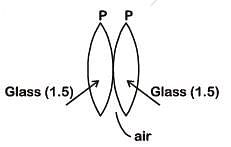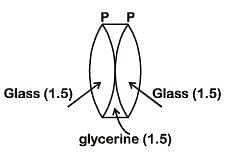NEET Exam > NEET Questions > Two similar thin equi-convex lenses, of focal...
Start Learning for Free
Two similar thin equi-convex lenses, of focal length f each, are kept coaxially in contact with each other such that the focal length of the combination is F1. When the space between the two lenses is filled with glycerine (which has the same refractive index (μ = 1.5) as that of glass) then the equivalent focal length is F2. The ratio F1 : F2 will be :
- a)2 : 1
- b)1 : 2
- c)2 : 3
- d)3 : 4
Correct answer is option 'B'. Can you explain this answer?
| FREE This question is part of | Download PDF Attempt this Test |
Most Upvoted Answer
Two similar thin equi-convex lenses, of focal length f each, are kept ...


Equivalent focal length in air

When glycerin is filled inside, glycerin lens behaves like a diverging lens of focal length (–f)


Free Test
FREE
| Start Free Test |
Community Answer
Two similar thin equi-convex lenses, of focal length f each, are kept ...


Equivalent focal length in air

When glycerin is filled inside, glycerin lens behaves like a diverging lens of focal length (–f)


Attention NEET Students!
To make sure you are not studying endlessly, EduRev has designed NEET study material, with Structured Courses, Videos, & Test Series. Plus get personalized analysis, doubt solving and improvement plans to achieve a great score in NEET.

|
Explore Courses for NEET exam
|

|
Similar NEET Doubts
Two similar thin equi-convex lenses, of focal length f each, are kept coaxially in contact with each other such that the focal length of the combination is F1. When the space between the two lenses is filled with glycerine (which has the same refractive index (μ = 1.5) as that of glass) then the equivalent focal length is F2. The ratio F1 : F2 will be :a)2 : 1b)1 : 2c)2 : 3d)3 : 4Correct answer is option 'B'. Can you explain this answer?
Question Description
Two similar thin equi-convex lenses, of focal length f each, are kept coaxially in contact with each other such that the focal length of the combination is F1. When the space between the two lenses is filled with glycerine (which has the same refractive index (μ = 1.5) as that of glass) then the equivalent focal length is F2. The ratio F1 : F2 will be :a)2 : 1b)1 : 2c)2 : 3d)3 : 4Correct answer is option 'B'. Can you explain this answer? for NEET 2024 is part of NEET preparation. The Question and answers have been prepared according to the NEET exam syllabus. Information about Two similar thin equi-convex lenses, of focal length f each, are kept coaxially in contact with each other such that the focal length of the combination is F1. When the space between the two lenses is filled with glycerine (which has the same refractive index (μ = 1.5) as that of glass) then the equivalent focal length is F2. The ratio F1 : F2 will be :a)2 : 1b)1 : 2c)2 : 3d)3 : 4Correct answer is option 'B'. Can you explain this answer? covers all topics & solutions for NEET 2024 Exam. Find important definitions, questions, meanings, examples, exercises and tests below for Two similar thin equi-convex lenses, of focal length f each, are kept coaxially in contact with each other such that the focal length of the combination is F1. When the space between the two lenses is filled with glycerine (which has the same refractive index (μ = 1.5) as that of glass) then the equivalent focal length is F2. The ratio F1 : F2 will be :a)2 : 1b)1 : 2c)2 : 3d)3 : 4Correct answer is option 'B'. Can you explain this answer?.
Two similar thin equi-convex lenses, of focal length f each, are kept coaxially in contact with each other such that the focal length of the combination is F1. When the space between the two lenses is filled with glycerine (which has the same refractive index (μ = 1.5) as that of glass) then the equivalent focal length is F2. The ratio F1 : F2 will be :a)2 : 1b)1 : 2c)2 : 3d)3 : 4Correct answer is option 'B'. Can you explain this answer? for NEET 2024 is part of NEET preparation. The Question and answers have been prepared according to the NEET exam syllabus. Information about Two similar thin equi-convex lenses, of focal length f each, are kept coaxially in contact with each other such that the focal length of the combination is F1. When the space between the two lenses is filled with glycerine (which has the same refractive index (μ = 1.5) as that of glass) then the equivalent focal length is F2. The ratio F1 : F2 will be :a)2 : 1b)1 : 2c)2 : 3d)3 : 4Correct answer is option 'B'. Can you explain this answer? covers all topics & solutions for NEET 2024 Exam. Find important definitions, questions, meanings, examples, exercises and tests below for Two similar thin equi-convex lenses, of focal length f each, are kept coaxially in contact with each other such that the focal length of the combination is F1. When the space between the two lenses is filled with glycerine (which has the same refractive index (μ = 1.5) as that of glass) then the equivalent focal length is F2. The ratio F1 : F2 will be :a)2 : 1b)1 : 2c)2 : 3d)3 : 4Correct answer is option 'B'. Can you explain this answer?.
Solutions for Two similar thin equi-convex lenses, of focal length f each, are kept coaxially in contact with each other such that the focal length of the combination is F1. When the space between the two lenses is filled with glycerine (which has the same refractive index (μ = 1.5) as that of glass) then the equivalent focal length is F2. The ratio F1 : F2 will be :a)2 : 1b)1 : 2c)2 : 3d)3 : 4Correct answer is option 'B'. Can you explain this answer? in English & in Hindi are available as part of our courses for NEET.
Download more important topics, notes, lectures and mock test series for NEET Exam by signing up for free.
Here you can find the meaning of Two similar thin equi-convex lenses, of focal length f each, are kept coaxially in contact with each other such that the focal length of the combination is F1. When the space between the two lenses is filled with glycerine (which has the same refractive index (μ = 1.5) as that of glass) then the equivalent focal length is F2. The ratio F1 : F2 will be :a)2 : 1b)1 : 2c)2 : 3d)3 : 4Correct answer is option 'B'. Can you explain this answer? defined & explained in the simplest way possible. Besides giving the explanation of
Two similar thin equi-convex lenses, of focal length f each, are kept coaxially in contact with each other such that the focal length of the combination is F1. When the space between the two lenses is filled with glycerine (which has the same refractive index (μ = 1.5) as that of glass) then the equivalent focal length is F2. The ratio F1 : F2 will be :a)2 : 1b)1 : 2c)2 : 3d)3 : 4Correct answer is option 'B'. Can you explain this answer?, a detailed solution for Two similar thin equi-convex lenses, of focal length f each, are kept coaxially in contact with each other such that the focal length of the combination is F1. When the space between the two lenses is filled with glycerine (which has the same refractive index (μ = 1.5) as that of glass) then the equivalent focal length is F2. The ratio F1 : F2 will be :a)2 : 1b)1 : 2c)2 : 3d)3 : 4Correct answer is option 'B'. Can you explain this answer? has been provided alongside types of Two similar thin equi-convex lenses, of focal length f each, are kept coaxially in contact with each other such that the focal length of the combination is F1. When the space between the two lenses is filled with glycerine (which has the same refractive index (μ = 1.5) as that of glass) then the equivalent focal length is F2. The ratio F1 : F2 will be :a)2 : 1b)1 : 2c)2 : 3d)3 : 4Correct answer is option 'B'. Can you explain this answer? theory, EduRev gives you an
ample number of questions to practice Two similar thin equi-convex lenses, of focal length f each, are kept coaxially in contact with each other such that the focal length of the combination is F1. When the space between the two lenses is filled with glycerine (which has the same refractive index (μ = 1.5) as that of glass) then the equivalent focal length is F2. The ratio F1 : F2 will be :a)2 : 1b)1 : 2c)2 : 3d)3 : 4Correct answer is option 'B'. Can you explain this answer? tests, examples and also practice NEET tests.

|
Explore Courses for NEET exam
|

|
Suggested Free Tests
Signup for Free!
Signup to see your scores go up within 7 days! Learn & Practice with 1000+ FREE Notes, Videos & Tests.
























